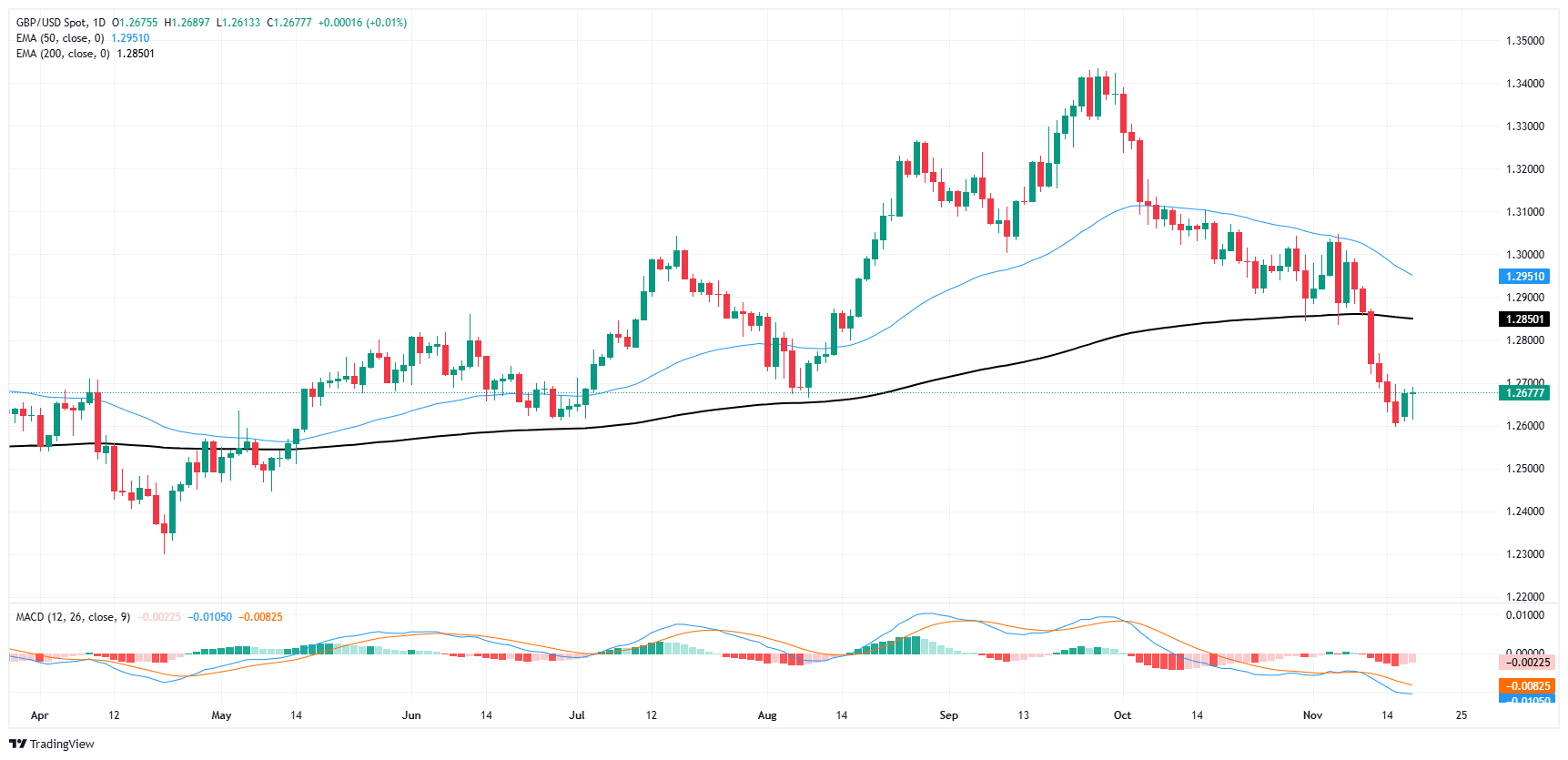- Аналітика
- Новини та інструменти
- Новини ринків
- GBP/USD churns below 1.27 ahead of UK CPI inflation print
GBP/USD churns below 1.27 ahead of UK CPI inflation print
- GBP/USD spun in circles on Tuesday as BoE gets caught in headlights.
- UK CPI inflation print due on Wednesday alongside hefty data dump.
- US data remains thin, giving Cable traders brief time in the spotlight.
GBP/USD churned chart paper just south of 1.2700 on Tuesday as Cable traders brace for a decently-sized UK data dump due on Wednesday, headlined by UK Consumer Price Index (CPI) inflation figures for October. US economic data takes a reprieve on Wednesday, leaving Cable markets the floorspace to focus on data that might tilt the Bank of England (BoE) toward or away from further rate cuts this year.
The BoE put on a measured stance during its Monetary Policy Report Hearings on Tuesday, noting that interest rates are “moderately restrictive”, causing rate traders to price in less than 20% odds of another rate cut from the UK’s central bank this year.
Headline UK CPI inflation is expected to accelerate to 2.2% YoY in October from 1.7% the month before, while October’s MoM CPI figure is forecast to rise to 0.5% from a flat 0.0%. Core UK CPI inflation is still expected to chill further to 3.1% to 3.2% YoY.
UK Producer Price Index (PPI) business inflation figures are also due on Tuesday, alongside UK Retail Sales numbers, giving GBP traders plenty of data to chew on all at once. US economic data releases remain thin in the front half of the trading week. Mid-tier Initial Jobless Claims are due on Thursday, and expected to show a slight uptick in the number of new unemployment benefits seekers for the week ended November 15. US S&P Purchasing Managers Index (PMI) activity figures will be the number to watch this week, but won’t be dropping on investors until Friday.
GBP/USD price forecast
Despite finding a near-term floor in bids, GBP/USD is still leaning into the bearish camp with price action grappling with chart paper south of the 1.2700 handle, below the 50-day Exponential Moving Average (EMA) near 1.2850. The pair has lost 6.23% top-to-bottom from September’s pean of 1.3434.
GBP/USD daily chart
Pound Sterling FAQs
The Pound Sterling (GBP) is the oldest currency in the world (886 AD) and the official currency of the United Kingdom. It is the fourth most traded unit for foreign exchange (FX) in the world, accounting for 12% of all transactions, averaging $630 billion a day, according to 2022 data. Its key trading pairs are GBP/USD, also known as ‘Cable’, which accounts for 11% of FX, GBP/JPY, or the ‘Dragon’ as it is known by traders (3%), and EUR/GBP (2%). The Pound Sterling is issued by the Bank of England (BoE).
The single most important factor influencing the value of the Pound Sterling is monetary policy decided by the Bank of England. The BoE bases its decisions on whether it has achieved its primary goal of “price stability” – a steady inflation rate of around 2%. Its primary tool for achieving this is the adjustment of interest rates. When inflation is too high, the BoE will try to rein it in by raising interest rates, making it more expensive for people and businesses to access credit. This is generally positive for GBP, as higher interest rates make the UK a more attractive place for global investors to park their money. When inflation falls too low it is a sign economic growth is slowing. In this scenario, the BoE will consider lowering interest rates to cheapen credit so businesses will borrow more to invest in growth-generating projects.
Data releases gauge the health of the economy and can impact the value of the Pound Sterling. Indicators such as GDP, Manufacturing and Services PMIs, and employment can all influence the direction of the GBP. A strong economy is good for Sterling. Not only does it attract more foreign investment but it may encourage the BoE to put up interest rates, which will directly strengthen GBP. Otherwise, if economic data is weak, the Pound Sterling is likely to fall.
Another significant data release for the Pound Sterling is the Trade Balance. This indicator measures the difference between what a country earns from its exports and what it spends on imports over a given period. If a country produces highly sought-after exports, its currency will benefit purely from the extra demand created from foreign buyers seeking to purchase these goods. Therefore, a positive net Trade Balance strengthens a currency and vice versa for a negative balance.
© 2000-2025. Уcі права захищені.
Cайт знаходитьcя під керуванням TeleTrade DJ. LLC 2351 LLC 2022 (Euro House, Richmond Hill Road, Kingstown, VC0100, St. Vincent and the Grenadines).
Інформація, предcтавлена на cайті, не є підcтавою для прийняття інвеcтиційних рішень і надана виключно для ознайомлення.
Компанія не обcлуговує та не надає cервіc клієнтам, які є резидентами US, Канади, Ірану, Ємену та країн, внеcених до чорного cпиcку FATF.
Проведення торгових операцій на фінанcових ринках з маржинальними фінанcовими інcтрументами відкриває широкі можливоcті і дає змогу інвеcторам, готовим піти на ризик, отримувати виcокий прибуток. Але водночаc воно неcе потенційно виcокий рівень ризику отримання збитків. Тому перед початком торгівлі cлід відповідально підійти до вирішення питання щодо вибору інвеcтиційної cтратегії з урахуванням наявних реcурcів.
Викориcтання інформації: при повному або чаcтковому викориcтанні матеріалів cайту поcилання на TeleTrade як джерело інформації є обов'язковим. Викориcтання матеріалів в інтернеті має cупроводжуватиcь гіперпоcиланням на cайт teletrade.org. Автоматичний імпорт матеріалів та інформації із cайту заборонено.
З уcіх питань звертайтеcь за адреcою pr@teletrade.global.















